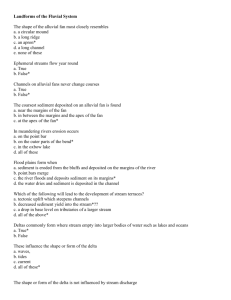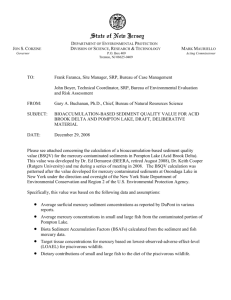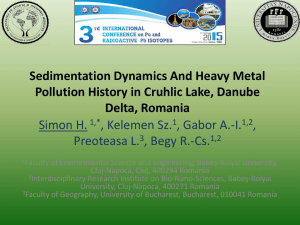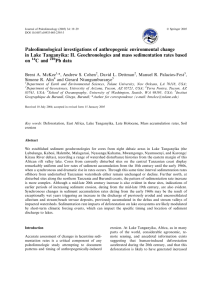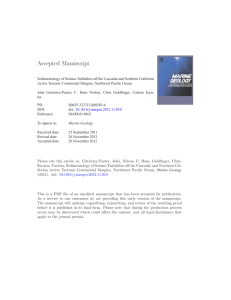Girardclos_Stephanie_Talk
advertisement
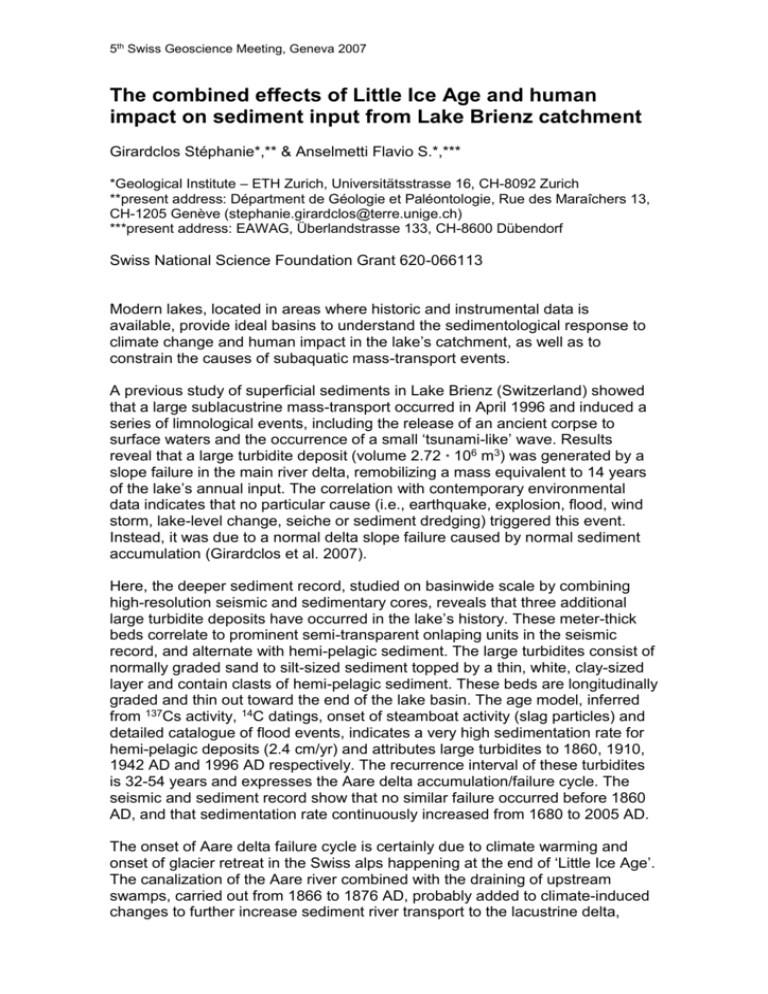
5th Swiss Geoscience Meeting, Geneva 2007 The combined effects of Little Ice Age and human impact on sediment input from Lake Brienz catchment Girardclos Stéphanie*,** & Anselmetti Flavio S.*,*** *Geological Institute – ETH Zurich, Universitätsstrasse 16, CH-8092 Zurich **present address: Départment de Géologie et Paléontologie, Rue des Maraîchers 13, CH-1205 Genève (stephanie.girardclos@terre.unige.ch) ***present address: EAWAG, Überlandstrasse 133, CH-8600 Dübendorf Swiss National Science Foundation Grant 620-066113 Modern lakes, located in areas where historic and instrumental data is available, provide ideal basins to understand the sedimentological response to climate change and human impact in the lake’s catchment, as well as to constrain the causes of subaquatic mass-transport events. A previous study of superficial sediments in Lake Brienz (Switzerland) showed that a large sublacustrine mass-transport occurred in April 1996 and induced a series of limnological events, including the release of an ancient corpse to surface waters and the occurrence of a small ‘tsunami-like’ wave. Results reveal that a large turbidite deposit (volume 2.72 * 106 m3) was generated by a slope failure in the main river delta, remobilizing a mass equivalent to 14 years of the lake’s annual input. The correlation with contemporary environmental data indicates that no particular cause (i.e., earthquake, explosion, flood, wind storm, lake-level change, seiche or sediment dredging) triggered this event. Instead, it was due to a normal delta slope failure caused by normal sediment accumulation (Girardclos et al. 2007). Here, the deeper sediment record, studied on basinwide scale by combining high-resolution seismic and sedimentary cores, reveals that three additional large turbidite deposits have occurred in the lake’s history. These meter-thick beds correlate to prominent semi-transparent onlaping units in the seismic record, and alternate with hemi-pelagic sediment. The large turbidites consist of normally graded sand to silt-sized sediment topped by a thin, white, clay-sized layer and contain clasts of hemi-pelagic sediment. These beds are longitudinally graded and thin out toward the end of the lake basin. The age model, inferred from 137Cs activity, 14C datings, onset of steamboat activity (slag particles) and detailed catalogue of flood events, indicates a very high sedimentation rate for hemi-pelagic deposits (2.4 cm/yr) and attributes large turbidites to 1860, 1910, 1942 AD and 1996 AD respectively. The recurrence interval of these turbidites is 32-54 years and expresses the Aare delta accumulation/failure cycle. The seismic and sediment record show that no similar failure occurred before 1860 AD, and that sedimentation rate continuously increased from 1680 to 2005 AD. The onset of Aare delta failure cycle is certainly due to climate warming and onset of glacier retreat in the Swiss alps happening at the end of ‘Little Ice Age’. The canalization of the Aare river combined with the draining of upstream swamps, carried out from 1866 to 1876 AD, probably added to climate-induced changes to further increase sediment river transport to the lacustrine delta, 5th Swiss Geoscience Meeting, Geneva 2007 ultimately leading to higher delta instability. The proportional decrease of turbidites vs. hemi-pelagic deposits which occurred since ~1940 AD seems to be caused by the construction of Grimsel hydropower dams (started in 1929, completed in 1955) in the lake’s catchment, as 2/3 of the ‘natural’ Aare river load, consisting mostly of coarse sediment, is trapped in the reservoirs (Anselmetti et al. 2007). Figure 1. Lake Brienz sediment core transect. Megaturbidites start at the end of Little Ice Age, occurring in 1860, 1910, 1942 and 1996 AD. REFERENCES Girardclos, S., Sturm, M., Schmidt, O.T., Ariztegui, D., Pugin, A. & Anselmetti F.S. 2007: The 1996 AD delta collapse and large turbidite in Lake Brienz. Marine Geology, 241, 137-154. Anselmetti, F.S., Bühler, R., Finger, D., Girardclos, S., Lancini, A., Rellstab, C. & Sturm M. 2007: Effects of Alpine hydropower dams on particle transport and lacustrine sedimentation. Aquatic Sciences, 69, 179-198.



